Belt-drive turntables are quite popular among audiophiles due to their sound quality. But like any other machine, they come with their own set of limitations, one of which is a worn-out belt. If you own a belt-drive turntable, chances are you will face this issue as the belt will be worn out in between 3-5 years, depending upon how extensively you use your turntable. In worst cases, the belt can even break on its own, leaving you with no choice other than to change the turntable belt.
So how to deal when this situation? Don’t worry, I have your back.
Just order a replacement belt for your exact turntable model, remove the platter, and replace the old belt with the new one. Check if the new belt is perfectly aligned around the circumference of the platter and is threaded well to the motor spindle, and it’s done.
I know you must be thinking it can’t be that easy, but trust me, it is if you follow the right instructions.
And that’s why I am here to help vinyl enthusiasts like you to fix their turntable, so allow me.
What is a turntable belt?
A turntable belt is a rubber belt that connects the platter (circular platform on which you place vinyl) to the motor. The belt ensures the platter rotates at the desired speed to give you the best sound experience possible.
If we compare belt drive vs direct drive turntables, direct drive turntables don’t use a belt as an additional component; rather, they have a motor directly placed under the platter. But today, we are only going to talk about belt-drive turntables. The belt drive is known to elevate sound quality by diminishing vibration and unnecessary noise caused by the motor.
At last, the belt acts as a mediator that keeps your vinyl and tonearm in sync for smooth operation. You can call it an unrecognized protagonist, without which your turntable cannot function properly.
Recognizing when you need to change your turntable belt
Here are some of the signs that you need to look for to know if turntable belt needs to be changed with a new one.
Difficulty in maintaining speed
One of the reasons that a belt needs a replacement is the fluctuation in platter speed. If, while playing your favourite record, you notice a distortion in sound, it’s a clear sign that the turntable is struggling to maintain a constant speed because of inadequate traction due to the worn-out belt.
Visible wear and tear
Inspect the belt and check for any signs of wear, like cracks, fraying and stretching. If you notice any damage, it’s high time to get a new belt for your record player.
The platter is not spinning at all
Another scenario that indicates that the belt is damaged is when you turn on the turntable and the platter fails to even start. It is a clear indication that you need to buy a new replacement belt for your turntable.
Already passed its Lifespan
The belt has a life span of 3-5 years. If you are an active vinyl listener and suspect your record player belt has already surpassed its Lifespan. In that case, it’s advisable to replace it before it stretches or breaks into pieces and further damages other record player parts.
Ordering the replacement
Once you have determined that your turntable belt needs a replacement, you can order a new one for it. Before placing an order, read your turntable manual to know about the specifications. After that, just visit the manufacturer’s website to order the replacement part, or google your specific turntable model and add a “replacement belt” to it, and you will find multiple websites selling it.
If you are still clueless and need additional help, you can visit the manufacturer’s website and ask them which belt is suitable for your specific model. You can also visit your nearest electronic store to purchase a suitable one.
Steps to replace the turntable belt with a new one
Now that you’ve got the new belt, it’s time to swap out the old one. Ready to go?
1. Lift the platter
Start with switching off the turntable, and after that, remove the platter by gently lifting it off. You may find the belt around the platter or fallen beneath it.
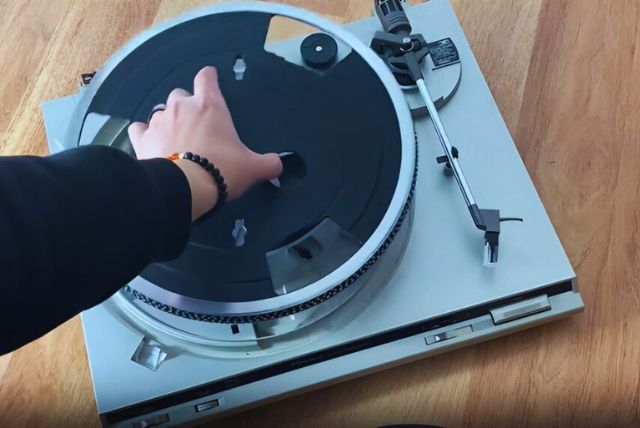
2. Remove the old belt
If you find the belt is still around the platter, gently remove it. Don’t throw away the old belt just now, as it serves as a guide to determine the proper length for the new one.
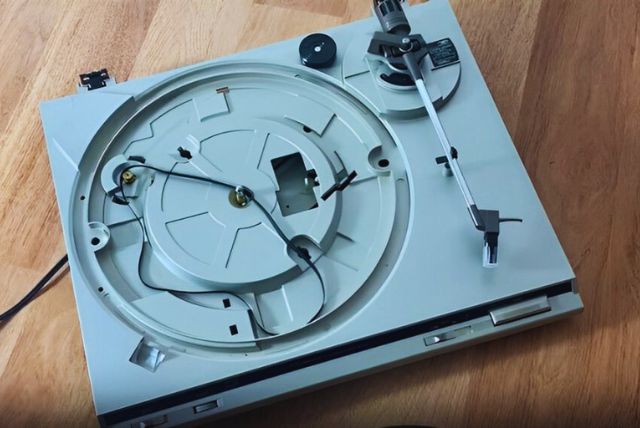
3. Compare the size of the old belt with the new
Before placing the new belt on the platter, make sure it’s of the right size. If the old belt is still in one piece, compare the size of the old one with the new one. Correct size is important because if the new belt is too loose, the platter will not rotate properly, and if it’s too tight, it will put a strain on the turntable motor.
4. Install the new one
Place the new belt around the platter following the circular ridge typically provided as a guide. After that, give the platter a few spins to assist the belt in locating its proper position.
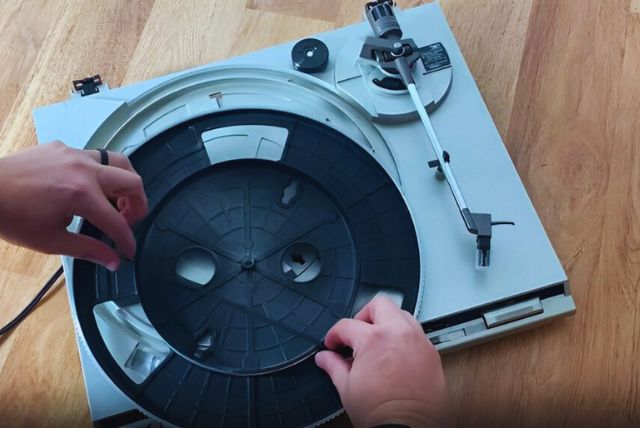
5. Connect the belt to the motor
Now, carefully place the belt on the motor pulley or spindle, ensuring a snug fit. After that, rotate the platter and check if the belt moves smoothly with the appropriate tension.
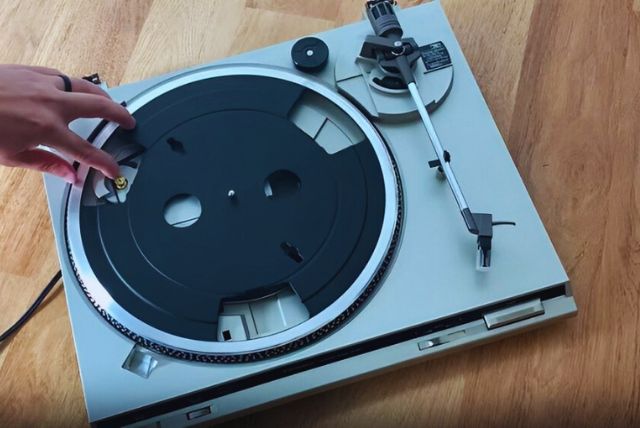
6. Reinstall the platter
Now, reinstall the platter in its designated place and make sure it’s properly positioned.
You can now switch on your turntable and enjoy the enhanced sound quality.
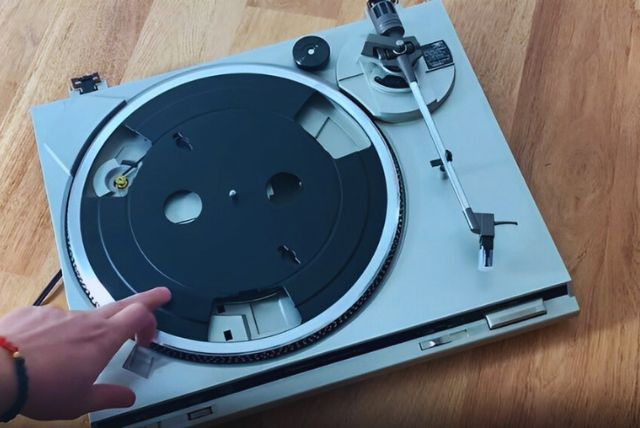
Tips to extend the Lifespan of your turntable belt
Some of the tips to maintain your belt and extend its lifespan.
Ensure its clean
Dust and debris can damage the belt if neglected. Regularly clean your belt and platter with a soft and dry cloth to remove any dust particles. Avoid using harsh chemicals as they can damage the belt.
Prevent excessive stretching
Be gentle whenever you are removing the belt for maintenance. Excess pressure can affect its elasticity and reduce its tension on the platter and the motor.
Store properly
If you decide to pack away your turntable, it’s advisable to remove the belt to prevent any unnecessary tension.
Keep away from heat and sunlight
Excess heat and sunlight not only affect your vinyl records but can also degrade the rubber material of the belt over time. Always keep your turntable away from direct sunlight and heat sources such as a room heater.
Final beat
The belt has a lifespan of a few years that is directly dependent on the usage. If you are someone who loves to play vinyl records regularly, the chances of a worn-out belt are much higher.
Stay alert for signs of a worn-out belt that could break and cause damage to your turntable.
Fortunately, replacing it is easy and won’t take long if you follow the mentioned steps.
If you encounter any further issues, feel free to reach out. Simply leave a comment below, and I’ll be glad to lend a hand.
Frequently Asked Questions
Q: How do I know if my turntable belt is bad?
If, while playing a record, you see dips in speed or the turntable cannot switch the speed from 33 RPM to either 45 RPM or 78 RPM, it’s a clear sign that the turntable belt needs a replacement. To be extra sure, you can also check for any wear and tear on the belt.
Q: How long does a turntable belt last?
The lifespan of the belt depends upon its quality, elasticity, and use. A turntable belt can last up to 5-6 years with fair use.


